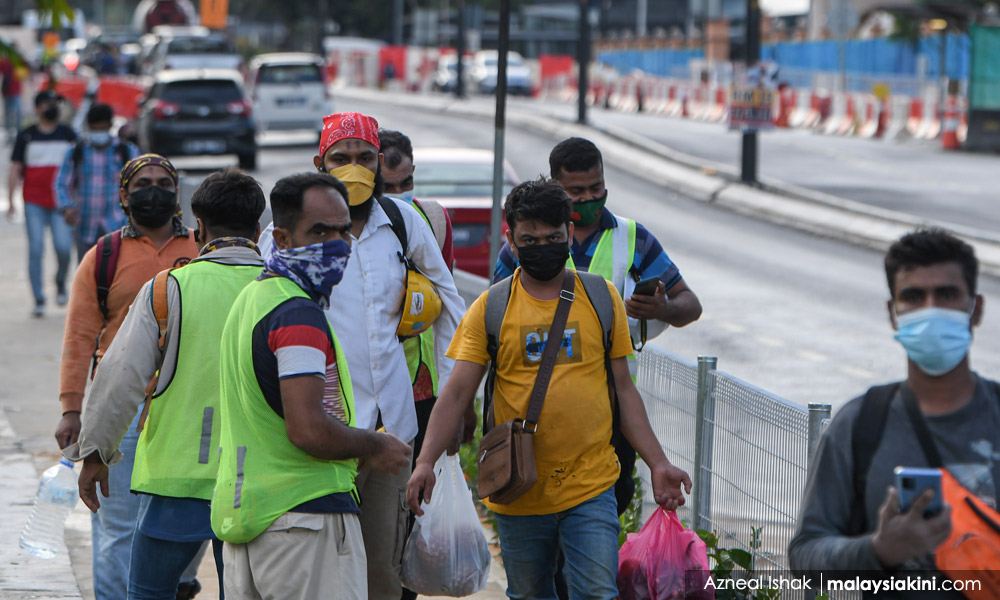What do you think is the single most important economic statistic right now for Malaysia? Think about it a little before you answer. Now decide if the figure proposed - the number of migrant workers in Malaysia - is the one.
One of the enduring mysteries in Malaysia is the number of migrant workers here. While the official figure is 2.1 million, according to the Statistics Department, this number may be as low as a third of total migrant labour, which includes undocumented labour.
This figure is important because it will tell us the magnitude of the problem we face. It relates back to how and whether we can help the poor in Malaysia. It will raise many questions about whether we are productive. It will tell us how deep in economic problems we are mired.
It requires the attention of the prime minister and the economy minister. This is no exaggeration. Getting a proper grasp of the problem will be key to lifting living standards for most Malaysians while being fair to our guest workers.
Most importantly, it will force us to finally face up to the enormous problem of migrant labour - both documented and undocumented - which impacts our economy and the well-being of every single person living in the country.
No, it is not the fault of migrant labourers, it is our own fault and the fault of successive incompetent, interfering governments beginning with Dr Mahathir Mohamad’s in 1981 which went the route of cheap labour and low value-added industry to fuel growth.

How do we estimate the real number? Many anecdotal numbers based on the interaction of Malaysians with undocumented labourers put the number at around the same as legal labourers - perhaps around two million, to make a total of around four million workers.
But hang on, in late 2014, then human resources minister Richard Riot said that there were 2.1 million documented migrant workers and 4.6 million undocumented, making a total of 6.7 million - imagine, 70 percent of migrant workers were undocumented! Apparently, this figure was based on mobile phone data which indicates a high degree of accuracy.
But as pointed out in this paper by Lee Hwok-Aun and Khor Yu Leng, published in April 2018 and which gives a good account of undocumented labour numbers, the 6.7 million figure has been steeply revised downward. I could not find the latest government estimates for undocumented labour.
Needlessly persisting conundrum
The paper estimated the minimum number of migrant workers at about 3.85 million and “possibly around 5.5 million.” But is the figure important? Most certainly it is.
First, it distorts economic performance considerably. Let’s take the 6.7 million figure - which implies an additional 4.7 million workers to the legal workforce or nearly 30 percent of the current legal workforce of 15 million.
Reported worker productivity will be much higher because 4.7 million workers are not recognised, distorting the figure upwards. Also, understating the population by 4.7 million or around 15 percent pushes the per capita income higher by the same percentage.
This caused prominent economist Jomo Sundaram, a former member of the Council of Eminent Persons under Mahathir’s second term as PM, to lament in June last year that the country has misleading data on labour and migrant workers, warning that it has led to a failure to get a grasp of serious issues.

What is more important is that the huge influx of migrant labour has had a rather deleterious effect on Malaysia. It caused huge distortions in the market for labour, keeping wages depressed for Malaysian labour artificially.
Look at it this way - if we imported cheap doctors from India in the thousands to deal with a doctor shortage in Malaysia, it will result in a plunge in doctors’ wages. Ditto for all the professions ranging from lawyers to accountants, engineers, and for any other occupation.
But strangely, we import millions of workers from overseas and allow millions more to work illegally and artificially depress the wages of Malaysian workers and don’t bat an eyelid. After deducting the migrant workers, official figures put the Malaysian workforce at around 13 million.
Perhaps as many as two-thirds of Malaysian workers or some 8.7 million Malaysians are manual and semi-skilled workers who compete directly for jobs with 6.7 million cheap migrant labourers! What chance do they have?
Of the 8.7 million, at least 70 percent are likely to be Malays and other bumiputeras, a total of some six million in all. Their lives and that of their dependents are doomed to poverty.
Now we can see the origins of Malay poverty, and the poverty of other Malaysians - a succession of poor governments, starting with Mahathir’s. And these same people now talk of Malay poverty, coolly ignoring their role here.
Distorting natural wage mechanism
The low wage argument was supported by a March 2018 Bank Negara Malaysia paper titled Low-Skilled Foreign Workers’ Distortions to the Economy.
It stated: “Malaysia’s transition to a high-income and developed nation is at risk, as long as firms are still engaged on a ‘race to the bottom’ in relation to labour costs and are unwilling to pay more, despite commensurable productivity gains had they adjusted.

“Employment of cheaper foreign workers vis-à-vis locals allows employers to keep wages low and in doing so, obviates the pressure to change the status quo. This distorts the natural wage clearing mechanisms that would have otherwise driven wages upwards.”
That’s a damning indictment against Malaysian employers in general who take the quick, easy option of cheap migrant labour and the government which has allowed and increased the practice over decades. For advocates of cheap labour, I recommend they read this paper.
Some steps are long overdue. The government needs to empower the Statistics Department to make proper estimates of migrant labour - both documented and undocumented - de-politicise the figures and make them public. Once this is done, it must have a plan to reduce migrant labour - over a period of say five years to no more than 15 percent of the workforce.
And finally, it must force employers and incentivise them to go towards automation, use innovation, and streamline operations towards higher productivity. That can only come about if they are required to pay for the real cost of labour.
Other countries - such as Australia - have done it without abusing cheap migrant labour. So can we. Otherwise, we are not removing the most persistent cause of poor productivity in Malaysia, and therefore of poverty too. - Mkini
P GUNASEGARAM hopes the new coalition government can do some groundwork to get a consensus from all stakeholders for such a move to revamp migrant labour. There is no reason for them to disagree because it will help their constituents.
The views expressed here are those of the author/contributor and do not necessarily represent the views of MMKtT.



No comments:
Post a Comment
Note: Only a member of this blog may post a comment.